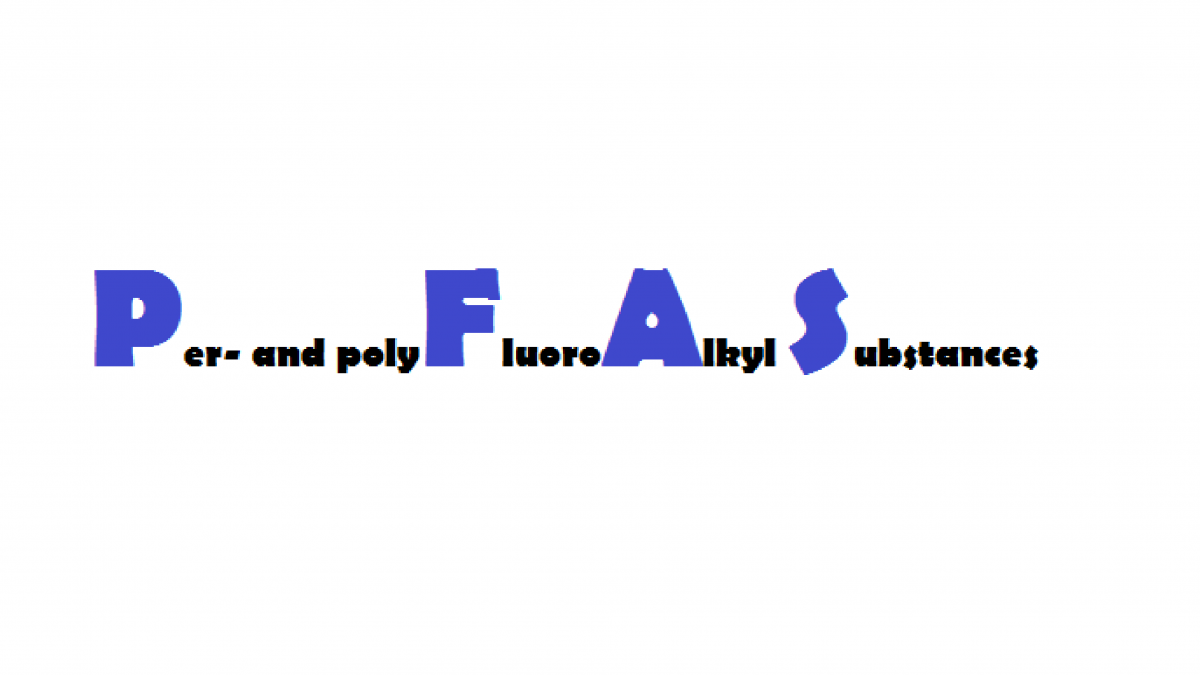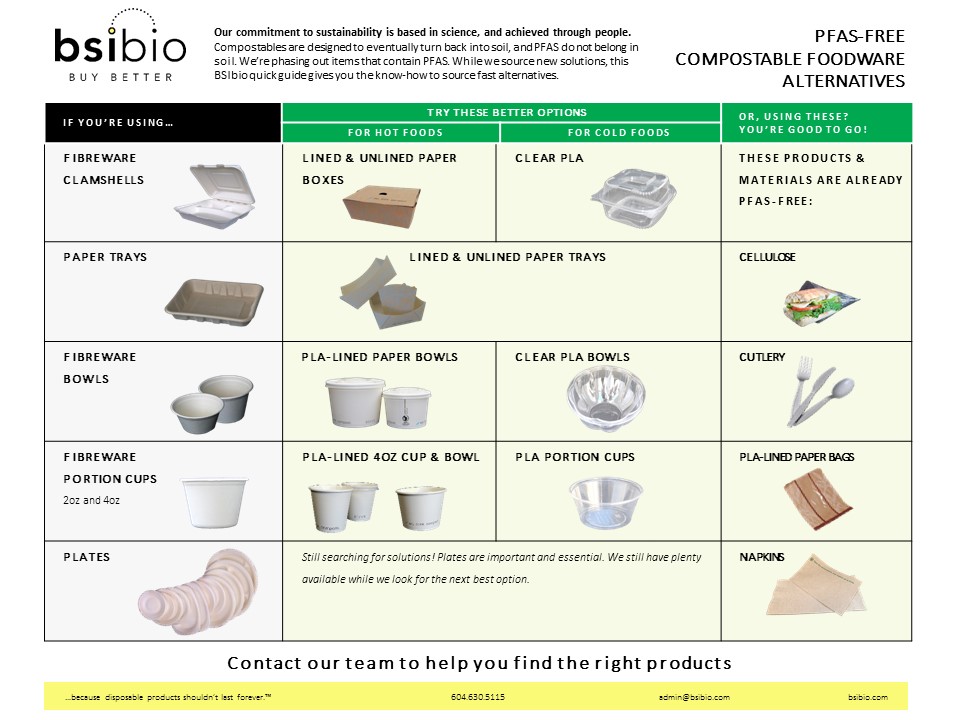
Reach your New Year’s Resolution with Less Waste!
January 30, 2019All You Need to Know About PFAS and How to Avoid Them

What are PFAS and Why do they Matter?
PFAS stands for Per- or poly-fluoroalkyl substances. This is a wide group of synthesized chemicals. PFAS are used as additives to create water- and grease-resistant materials. They have been in use since the 1940s in a wide array of everyday objects, including carpets, clothing, polishes, paints, waxes, and – very important to us – food packaging and food serviceware. Much of the paper food packaging, including sugarcane and other plant fiber containers, used today contain some form of PFAS to help it function with saucy or wet foods.
Much of the paper food packaging, including sugarcane and other plant fiber containers, used today contain some form of PFAS
“Forever Chemicals”
PFAS are highly persistent in our environment, meaning they last a long time and are difficult to break down. PFAS have been shown to accumulate in plants and animals. Their use in applications as diverse as fire extinguishing fluids to clothing result in the chemicals being found everywhere from water to soil. Recent research suggests a link between PFAS and adverse health effects in animals and humans.
PFAS are persisting in the environment and may be linked to adverse health effects.
There are over 5,000 types of PFAS chemicals. A number of chemicals under the group of PFAS have already been banned for manufacture and use in different areas worldwide. More bans are going into effect as more research is available. In particular, water quality guidelines are including the use of PFAS as a chemical of emerging concern.
Where are PFAS in foodware?
Any paper product without a lining to protect it from wet or oily foods tend to contain water and grease-resistant additives. Common items like pastry bags, burger wraps, paper plates, and fibre clamshells are likely to contain PFAS.
Are PFAS in Compostable Products?
Yes, even certified compostable food serviceware and food packaging can contain trace levels of PFAS, and that includes some of the items we sell. Although exposure to PFAS/PFOS through food is well below what is considered unsafe for humans, we do not think PFAS belong in compostable packaging, nor in compost. Neither does our compostability certifier the Biodegradable Products Institute. They are decertifying items with added PFAS in them as of January 1, 2020.
Products containing added PFAS will no longer be certified compostable as of January 1, 2020.
Are There Alternatives to Products with PFAS?
Yes, you can avoid serving food in products containing PFAS. BSIbio has a range of products that have no added PFAS. See our post on PFAS and Alternatives or download our factsheet here:

Quick Tips for PFAS-free Compostable Alternatives
- BESICs lined paper products like soup bowls and hot cups do not have PFAS
- Clear and opaque PLA products do not have PFAS
- Some unlined paper products do not have PFAS – ask us to make sure!
What’s BSIbio Doing About It?
At BSIbio, we value packaging that is both healthy for you and the environment. We strive to work with materials that leave no questions about the quality of compost. We are working with our manufacturers on finding practical alternatives to our current products, and researching new materials.
Meanwhile, if you are a customer or someone who currently orders products containing PFAS, reach out to us to discuss the alternatives.
As the industry shifts and BSIbio finds solutions, we ask for patience and support as we take the time and care critical to ensuring you that our products meet your needs with no question marks attached.
Resources to Learn More about PFAS
There’s a lot to learn about PFAS chemistry and materials, their role in our modern lives, and how we’re responding to them globally. These are just a few of the additional articles and resources where you can learn more about PFAS.
- The US Environmental Protection Agency – Basic Information on PFAS
- The US Food and Drug Administration – Per and Polyfluoroalkyl Substances
- Guidelines for Canadian Drinking Water Quality: Guideline Technical Document – Perfluorooctane Sulfonate (PFOS)

7 Comments
Recently I became aware of the health hazards associated with PFAS.
Unfortunately, I’ve eaten a lot of microwave popcorn in the past.
Also, I have used paper plates in the microwave quite often.
For example, to make nachos with shredded cheese, and some of the cheese would stick to the paper plates.
Am I correct in thinking this increases the transfer of PFAS?
Thanks, Tony! You have pointed out one of the major challenges with PFAS in our food contact + consumer goods…We aren’t sure.
There is plenty of scientific evidence that PFAS/PFOS/PFOA accumulate….and remain in soil and water.
But, we don’t have enough data on exactly *HOW* they end up there. Or, on exactly which health problems they may cause. Fortunately, the Canadian and American EPAs have been following the EU’s lead, and more seriously discussing regulation for these chemicals in recent years (2020-now).
At BSIbio, we avoid PFAS because of the life cycle of our paper/fibre-based products (used compostable products are placed directly into the soil). While we wait to learn more, you are probably right to be cautious about heat, food contact, and these chemicals. :-/
Do microwave safe paper plates have PFAS?
Would those fiber bowl containers lined with PLA have pfas?
Hello Sarah! PLA-lined fibre bowls are PFAS-free. The lining is actually intended to replace the PFAS chemicals.
Since PFAS aren’t compostable, you can confirm PFAS content in your packaging by making sure they are *BPI Certified Compostable* with a Certification number clearly listed. This is a BPI member requirement & any certified products cannot contain added PFAS.
Wait so even the bare bone paper plates that don’t have linings contain pfas? I’m taking about the super cheap thin ones you have to pull apart. I assumed they wouldn’t since they don’t seem to have any kind of water or oil resistance.
Hi Savanna! Great question. :] Yes, those would contain PFAS. PFAS are used to treat UNLINED paper products like plant fibre clamshells and paper plates for oil and water resistance, and provide structure.
When we remove PFAS, many paper items like those can barely hold their shape, so we replace it with something bio-based like PLA. Unless a product specifically says it is PFAS free, assume most food-contact paper products contain PFAS. We’d love to chat if you still have questions
(604-630-5115)